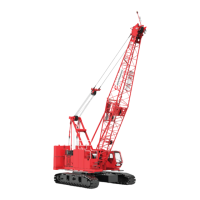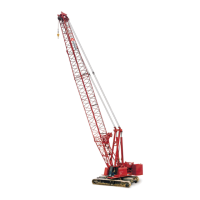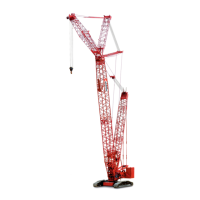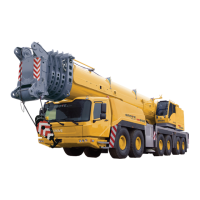OPERATING CONTROLS AND PROCEDURES MLC300 OPERATOR MANUAL
3-62
Published 11-20-19, Control # 234-19
OPERATING IN WIND
Wind adversely affects lifting capacity and stability. The
result could be loss of control over the load and crane, even
if the load is within the crane’s capacity.
Do not raise boom for the purpose of measuring the wind
speed with the crane’s anemometer.
Wind speed (to include wind gusts) must be monitored by job
planners and supervisors.
The wind speed at the boom or jib point can be greater than
the wind speed at ground level. Also be aware that the larger
the sail area of the load, the greater the wind’s affect on the
load.
As a general rule, ratings and operating speeds must be
reduced when the wind causes load to swing forward
past allowable operating radius or sideways past either
boom hinge pin.
For wind conditions specific to this crane, see the Wind
Conditions chart at the end of this section or, if applicable,
see the wind conditions in the capacity charts provided with
the crane and attachment.
CRAWLER BLOCKING
To prevent the crane from tipping, some boom and jib
lengths require blocked crawlers. See the appropriate
Liftcrane Boom or Jib Capacities chart for blocked crawler
requirements.
For crawler blocking dimensions and instructions, see the
Crawler Blocking topic in the Capacity Chart Information folio
located in the Capacity Chart Manual supplied with the
crane.
INTERMEDIATE SUSPENSION
If required per the rigging drawing in use (boom and luffing
jib), make sure the intermediate suspension is properly
installed. Otherwise, damage to the boom sections can
occur.
For some boom and luffing jib configurations, it is normal for
the intermediate suspension to appear slack during boom
and luffing jib raising and operation. If your intermediate
suspension appears slack —
• make sure it is installed in the proper location,
• make sure the proper pendant buttons are pinned to the
sockets,
and continue operation.
WARNING
Tipping Crane Hazard
The judgment and experience of qualified operators, job
planners, and supervisors shall be used to compensate
for the affect of wind on the lifted load and the boom by
reducing ratings or operating speeds, or a combination of
both.
Failing to observe this precaution can cause the crane to
tip or the boom and/or jib to collapse. Death or serious
injury to personnel can result.
DANGER
Tipping Hazard!
Do not attempt to raise or lower the boom or the boom
and jib from or to ground level until the crawlers are
blocked, if required. Otherwise, the crane will tip.

